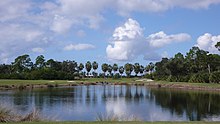Hazard (golf)
It has been suggested that this article should be split into articles titled Bunker (golf) and Penalty area (golf). (discuss) (October 2024) |


A hazard is an area of a golf course in the sport of golf which provides a difficult obstacle, which may be of two types: (1) penalty areas such as lakes and rivers; and (2) bunkers. A penalty area was previously referred to as a water hazard. Special rules apply to play balls that fall in a hazard. For example, a player may not touch the ground with their club before playing a ball, not even for a practice swing. A ball in any hazard may be played as it lies without penalty. If it cannot be played from the hazard, the ball may be hit from another location, generally with a penalty of one stroke. The Rules of Golf govern exactly from where the ball may be played outside a hazard. Bunkers (or sand traps) are shallow pits filled with sand and generally incorporating a raised lip or barrier, from which the ball is more difficult to play than from grass.[1]
Bunker
[edit]
A bunker is a depression, commonly near the green or fairway, that is usually filled with sand. Playing the ball from a bunker is considered more difficult than from closely mown grass, and to do so proficiently requires a high degree of skill. A specialized club called a "sand wedge" is designed for extracting the ball from a bunker. Specific rules of golf govern play from a bunker. For example, a player may not ground their club in a bunker; that is, the club cannot touch the ground before the swing.
According to the etiquette of the game, the player (or their caddie) is expected to smooth the area of the sand disturbed, normally using a rake, in order that conditions are similar for all subsequent players.
According to Kathryn Baker, curator, British Golf Museum, St. Andrews, Scotland[2], sand traps were formed out of natural depressions in the landscape because "the sheep would burrow down behind them (dunes) to take shelter from the wind. Over time, these areas hollowed out to form the bunkers, or as you Yanks say, sand traps."
Old Tom Morris is said to be responsible for maintaining sand traps and hazards to form playable conditions, using rakes to create surfaces that were more predictable than the natural hazards they once were. Additionally, he is said to have been a pioneer in the modern idea of placing hazards so that the golf ball could be routed around them, forming the beginning of strategic golf course design.
Types of bunkers
[edit]There are three types of bunkers used in golf course architecture and all are designed to be impediments to the golfer's progress toward the green. Fairway bunkers are designed primarily to gather up wayward tee shots on par 4 and par 5 holes; they are located to the sides of the fairway or even in the middle of the fairway. Greenside bunkers are designed to collect wayward approach shots on long holes and tee shots on par 3 holes; they are located near and around the green. Waste bunkers are natural sandy areas, usually very large and often found on links courses; they are not considered hazards according to the rules of golf, and so, unlike in fairway or greenside bunkers, golfers are permitted to ground a club lightly in, or remove loose impediments from, the area around the ball.[3]
Penalty areas
[edit]

Penalty areas, like bunkers, are natural obstacles designed to add both beauty and difficulty to a golf course. They are typically bodies of water or other areas where balls are frequently lost or irrecoverable. Penalty areas were formerly referred to as water hazards. Penalty areas are typically either streams or ponds, situated between the teeing ground and the hole.
Types of penalty area
[edit]Two types of penalty area exist: "red" penalty areas formerly known as "lateral water hazards" (marked with red stakes around the perimeter of the hazard) and yellow penalty areas (marked with yellow stakes). Red penalty areas are usually adjacent to the fairway being played (along the side), while yellow penalty areas generally cross the fairway being played forcing the player to hit over the penalty area.
References
[edit]- ^ Pelanda, Brian. "What's a 'Bunker'?: The Curious Case of How Dustin Johnson Lost the 2010 PGA Championship and Why the PGA Must Revise the Now Infamous Local Rule at Whistling Straits". Entertainment, Arts and Sports Law Journal. 22 (Fall/Winter 2011): 67. SSRN 1909575.
- ^ "ESPNMAG.com - Why do golf courses have sand traps?". www.espn.com. Retrieved 30 September 2024.
- ^ "USGA Explanation on Status Of "Waste Bunkers"". Archived from the original on 24 July 2010. Retrieved 12 August 2010.
